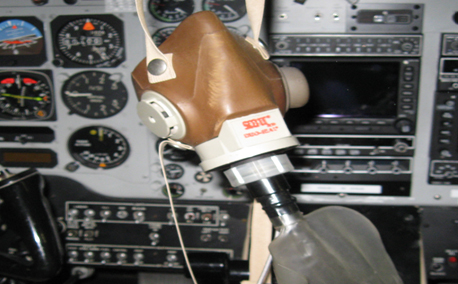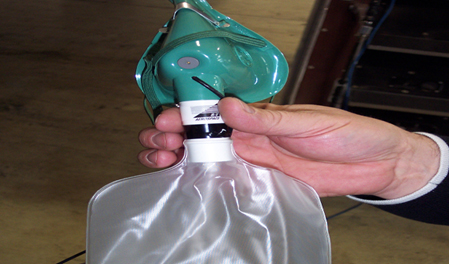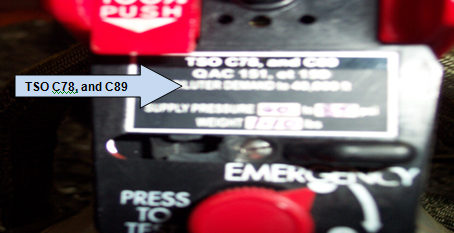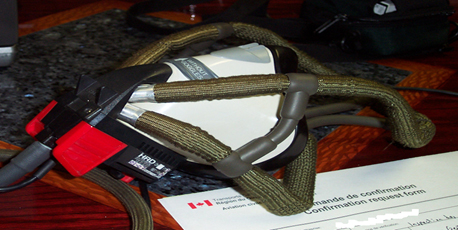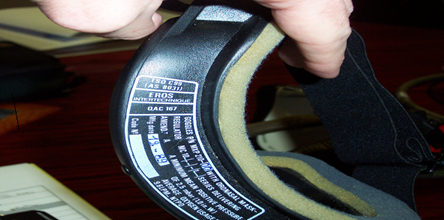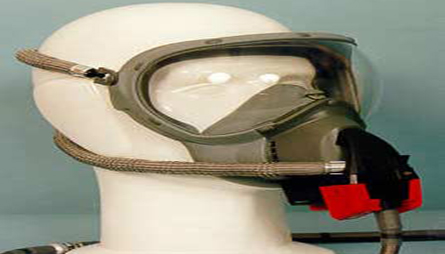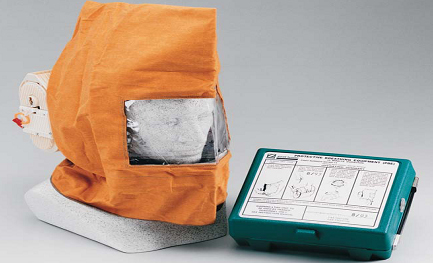From Transport Canada
Subject: Protective Breathing Equipment
| Issuing Office: | Standards |
|---|---|
| Document No.: | AC 700-032 |
| File Classification No.: | Z 5000-34 |
| Issue No.: | 01 |
| RDIMS No.: | 11059640 |
| Effective Date: | 2015-04-10 |
TABLE OF CONTENTS
- 1.0 INTRODUCTION
- 2.0 REFERENCES AND REQUIREMENTS
- 3.0 BACKGROUND
- 4.0 TRANSPORT CANADA POSITION
- 5.0 INFORMATION MANAGEMENT
- 6.0 DOCUMENT HISTORY
- 7.0 CONTACT OFFICE
- APPENDIX A — PROTECTIVE BREATHING EQUIPMENT
- APPENDIX B - EXEMPTION FROM SECTIONS 703.67 AND 704.66 OF THE CANADIAN AVIATION REGULATIONS
1.0 INTRODUCTION
- (1) This Advisory Circular (AC) is provided for information and guidance purposes. It describes an acceptable means of demonstrating compliance with regulations and standards. This AC on its own does not change, create, amend or permit deviations from regulatory requirements, nor does it establish minimum standards.
1.1 Purpose
- (1) Sections 703.67 and 704.66 of the Canadian Aviation Regulations (CARs) requires Protective Breathing Equipment (PBE) be installed in aircraft. Despite the requirement for PBE, many air taxi and commuter aircraft have never had this equipment installed. The purpose of this document is to advise, educate, and enforce the existing PBE requirements.
1.2 Applicability
- (1) This document applies to the aviation industry for information purpose.
1.3 Description of Changes
- (1) Nothing has changed other than reinforcing the importance of sections 703.67 and 704.66 of the CARs.
- (2) The current Exemption is now attached as Appendix B.
- Protective Breathing Equipment
- 703.67 (1) No air operator shall operate a pressurized aircraft unless protective breathing equipment with a 15-minute supply of breathing gas at a pressure-altitude of 8,000 feet is readily available at each flight crew member position.
- (3) The protective breathing equipment referred to in subsection (1) may be used to meet the crew member oxygen requirements specified in Section 605.31.
- Protective Breathing Equipment
- 704.66 (1) No air operator shall operate a pressurized aircraft unless protective breathing equipment with a 15-minute supply of breathing gas at a pressure-altitude of 8,000 feet is readily available at each flight crew member position.
- (2) The protective breathing equipment referred to in subsection (1) may be used to meet the crew member oxygen requirements specified in Section 605.31.
2.0 REFERENCES AND REQUIREMENTS
2.1 Reference Documents
- (1) It is intended that the following reference materials be used in conjunction with this document:
- (a) Part I, Subpart I of the Canadian Aviation Regulations (CARs) – Interpretation - Protective Breathing Equipment;
- (b) Part V, Subpart 21 of the CARs, – Standards of Air Worthiness;
- (c) Part V, Standards 551.405 of the CARs, – Protective Breathing Equipment (PBE);
- (d) Part VI, Subpart V, Division II of the CARs – Aircraft Equipment Requirements;
- (e) Part VII, Subpart III, Division V of the CARs - Aircraft Equipment Requirements;
- (f) Part VII, Subpart IV, Division V of the CARs - Aircraft Equipment Requirements;
- (g) Chapter 537 - Airworthiness Manual
- (h) Technical Standards Order (TSO) C78 - Crewmember Demand Oxygen Masks;
- (i) TSO C89a – Crewmember Oxygen Regulators Demand;
- (j) TSO C99a – Flight Deck (Sedentary), Protective Breathing Equipment (this document references various other standards (SAE, etc.) ;
- (k) TSO C116a – Crewmember Portable Protective Breathing Equipment;
- (l) Sections 6.6, 6.7 and 6.15 – Aviation Occupational Health and Safety Regulations.
2.2 Cancelled Documents
- (1) AC 700-032 Issue 01 has been cancelled.
- (2) By default, it is understood that the publication of a new issue of a document automatically renders any earlier issues of the same document null and void.
2.3 Definitions and Abbreviations
- (1) The following definition is used in this document:
- (a) Protective breathing equipment: means equipment designed to cover the eyes, nose and mouth of the wearer, or the nose and mouth where accessory equipment is provided to protect the eyes, and to protect the wearer from the effects of smoke, carbon dioxide or other harmful gases. (inhalateur protecteur) (Definition from section 101 of the CARs).
- (2) The following abbreviations are used in this document:
- (a) AC: Advisory Circular;
- (b) CARs: Canadian Aviation Regulations;
- (c) FAR: Federal Aviation Regulation;
- (d) PBE: Protective Breathing Equipment;
- (e) SI: Staff Instruction;
- (f) STC: Supplemental Type Certificate(s);
- (g) TSO: Technical Standards Order.
3.0 BACKGROUND
- (1) At present, FAR Part 23 aircraft are still manufactured with PBE standard that are not in compliance with the CARs. They do not meet the PBE requirements which differ from the oxygen mask requirements as follows: The PBE requirements specify protection for the nose and eyes, as well as the oxygen flow whereas oxygen masks do not provide smoke protection for the eyes. The occurrence of smoke, fire or fumes aboard a commercial aircraft presents a potentially dangerous situation. Accident data show in-flight fire with the fourth highest number of on board fatalities and the seventh highest category of accidents. In addition, data from recent years indicate the probability of passengers experiencing an in-flight smoke event is greater than one in 10,000.
4.0 TRANSPORT CANADA POSITION
- (1) The level of risk of operating aircraft without protective breathing equipment has been determined medium/high. Smoke in a cockpit is a threat of safety. As a response to the risk, the following sub-paragraphs shall be followed:
- (a) The effective date for compliance with sections 703.67 and 704.66 of the CARs is 01 May, 2016, 12 months after the publication of this AC.
- Air Operators are encouraged to install the appropriate PBE at the earliest opportunity. In the meantime, an exemption is issued for this period (Appendix B); and
- (b) Appendix "A" provides clarity with respect to the various CARs, TSOs and STCs governing protective breathing equipment as well as providing information on the types of units that will meet regulatory compliance requirements
5.0 INFORMATION MANAGEMENT
- (1) Not applicable.
6.0 DOCUMENT HISTORY
- (1) Not applicable.
7.0 CONTACT OFFICE
For more information, please contact the:
Chief, Commercial Flight Standards - AARTF
Phone: 613-990-1022
Fax: 613-954-1602
E-mail: deborah.martin@tc.gc.ca
Suggestions for amendment to this document are invited, and should be submitted via email at:
[original signed by]
Jacqueline Booth
Acting Director, Standards
Civil Aviation
APPENDIX A — PROTECTIVE BREATHING EQUIPMENT
This Appendix provides clarity with respect to the various CARs, TSOs and STCs governing protective breathing equipment while providing information on the types of units that will provide compliance.
1.0 CANADIAN AVIATION REGULATIONS
Paragraph 703.67 (1) and section 704.66 of the CARs are similar and read as follows:
Protective Breathing Equipment
703.67 (1) No air operator shall operate a pressurized aircraft unless protective breathing equipment with a 15-minute supply of breathing gas at a pressure-altitude of 8,000 feet is readily available at each flight crew member position.
(2) The protective breathing equipment referred to in subsection (1) may be used to meet the crew member oxygen requirements specified in section 605.31. Protective Breathing Equipment
704.66 (1) No air operator shall operate a pressurized aircraft unless protective breathing equipment with a 15-minute supply of breathing gas at a pressure-altitude of 8,000 feet is readily available at each flight crew member position.
(2) The protective breathing equipment referred to in subsection (1) may be used to meet the crew member oxygen requirements specified in section 605.31.
2.0 REGULATORY REQUIREMENTS
The following CAN- TSO C99a and CAN-TSO C116a meet the regulatory requirements specified in section 551.405 of the CARs:
CAN-TSO C99a Flight Deck (Sedentary) Crewmember Protective Breathing Equipment;
C99 protective breathing equipment meets TSO C78 and/or C89 standards, but includes smoke protection features. The mask can be combined with certified goggles (circulating fresh air) or can come as a full-face device. It also has communication capability and is stationary.
CAN-TSO C116a Crewmember Protective Breathing Equipment;
TSO C116 protective breathing equipment is a portable device (hood) and comes with its own oxygen generator. There is no communication capability as the device is designed to be portable
3.0 STANDARDS
The following CAN-TSO C78a and CAN-TSO C89a are part of the Airworthiness Standards Chapter 537 for Crewmember Demand Oxygen Masks:
CAN-TSO C78a Crewmember Demand Oxygen Mask;
CAN –TSO C89a Crewmember Oxygen Regulators Demand;
Note: CAN-TSO C78a and CAN-C89a masks are designed to meet the oxygen supply standard and have communication capability.
Example of non-TSO masks (Beech parts catalogue)
Although these masks meet the type certificate, they do not meet the CARs requirement to operate in Canada.
Image 1: Non TSO mask
Image 2: Non TSO mask
Example of CAN-TSO C78a and CAN-TSO C89a converted to CAN-TSO C99a
Image 3: CAN-TSO C78a and CAN-TSO C89a
Image 4: CAN-TSO C78a and CAN-TSO C89a
Note: Adding certified goggles on a CAN-TSO-089a mask does not make it legal unless the required holes on the nose of the mask that provide a positive pressure for eye protection and the CAN-TSO-099a certification is marked on the inside of the mask.
Image 5::CAN-TSO C78a and CAN- TSO C89a converted to CAN-TSO C99a.
Image 6:CAN-TSO C99a
Example of CAN-TSO C99a (full face mask)
Image 7: CAN-TSO C99a (full face mask)
Example of CAN-TSO C116a
Image 8: CAN-TSO C116a
Supplemental Type Certificate
Section 551.03 of the Standards
Equipment Installation Standards
In addition to meeting the requirements specified in this chapter, the installation of the equipment shall meet the applicable standards of the basis of certification of the aircraft.
Section 523.1441 of the Standards
Oxygen Equipment and Supply
- (a) If certification with supplemental oxygen equipment is requested, or the aeroplane is approved for operations at or above altitudes where oxygen is required to be used by the operating rules, oxygen equipment must be provided that meets the requirements of this section and 523.1443 through 523.1449. Portable oxygen equipment may be used to meet the requirements of this part if the portable equipment is shown to comply with the applicable requirements, is identified in the aeroplane type design, and its stowage provisions are found to be in compliance with the requirements of 523.561.
- (b) The oxygen system must be free from hazards in itself, in its method of operation, and its effect upon other components.
- (c) There must be a means to allow the crew to readily determine, during the flight, the quantity of oxygen available in each source of supply.
- (d) Each required flight crewmember must be provided with:
- (1) Demand oxygen equipment if the aeroplane is to be certificated for operation above 25,000 feet.
- (2) Pressure demand oxygen equipment if the aeroplane is to be certificated for operation above 40,000 feet.
- (e) There must be a means, readily available to the crew in flight, to turn on and to shut off the oxygen supply at the high pressure source. This shut-off requirement does not apply to chemical oxygen generators.
APPENDIX B - EXEMPTION FROM SECTIONS 703.67 AND 704.66 OF THE CANADIAN AVIATION REGULATIONS
EXEMPTION FROM Sections 703.67 and 704.66 OF THE CANADIAN AVIATION REGULATIONS
Pursuant to subsection 5.9(2) of the Aeronautics Act, and after taking into account that the exemption is in the public interest and is not likely to adversely affect aviation safety, I hereby exempt Canadian Operators, operating under Subpart 3 and 4 of Part VII of the Canadian Aviation Regulations (CARs), from the requirements of sections 703.67 and 704.66 of the CARs, subject to the following conditions.
Sections 703.67 and 704.66 of the CARs state that no air operator shall operate a pressurized aircraft unless protective breathing equipment with a 15- minute supply of breathing gas at a pressure-altitude of 8,000 feet is readily available at each flight crew member position.
The details of the above provisions are set out in Appendix A, attached to this exemption.
Purpose
The purpose of this exemption is to provide the Canadian Operators operating under Subpart 3 and 4 of Part VII of the Canadian Aviation Regulations (CARs) sufficient time to install the required Protective Breathing Equipment (PBE) in aircraft in accordance with sections 703.67 and 704.66 of the CARs.
Application
This exemption applies to all Canadian Operators operating under Subpart 3 and 4 of Part VII of the Canadian Aviation Regulations (CARs).
Conditions
This exemption is subject to the following conditions:
- 1. The air operators shall install the required Protective Breathing Equipment as per the requirements of sections 703.67 and 704.66 of the CARs within the 12 months validity period.
- 2. The air operators shall carry a copy of this exemption on board of their aircrafts operating under Subpart 3 and 4 of Part VII of the CARs.
Validity
This exemption is in effect until the earliest of the following:
- 1. May 01, 2016 at 23:59 (GMT)
- 2. The date on which any of the conditions set out in this exemption is breached; or
- 3. The date, on which this exemption is cancelled in writing by the Minister, where he is of the opinion that it is no longer in the public interest or that it is likely to adversely affect aviation safety.
DATED at Ottawa, Ontario, Canada this (date) day of (month), (year), on behalf of the Minister of Transport.
Martin J. Eley
Director General, Civil Aviation
Transport Canada
Appendix A
Protective Breathing Equipment
703.67 (1) No air operator shall operate a pressurized aircraft unless protective breathing equipment with a 15- minute supply of breathing gas at a pressure-altitude of 8,000 feet is readily available at each flight crew member position.
(2) The protective breathing equipment referred to in subsection (1) may be used to meet the crew member oxygen requirements specified in section 605.31.
Protective Breathing Equipment
704.66 (1) No air operator shall operate a pressurized aircraft unless protective breathing equipment with a 15- minute supply of breathing gas at a pressure-altitude of 8,000 feet is readily available at each flight crew member position.
(2) The protective breathing equipment referred to in subsection (1) may be used to meet the crew 1member oxygen requirements specified in section 605.31.
AC 700-032 - Protective Breathing Equipment
(PDF, 1.3 MB)
